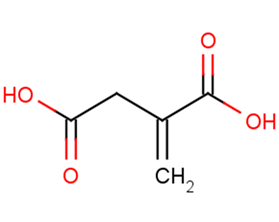
Itaconic acid
CAS No. 97-65-4
Itaconic acid( methylene-butanedioicaci )
Catalog No. M19675 CAS No. 97-65-4
Itaconic acid also known as itaconate belongs to the class of organic compounds known as branched fatty acids. These are fatty acids containing a branched chain. Itaconic acid exists as a solid soluble (in water) and a weakly acidic compound (based on its pKa). Itaconic acid has been detected in multiple biofluids such as sweat and urine.
Purity : >98% (HPLC)
 COA
COA
 Datasheet
Datasheet
 HNMR
HNMR
 HPLC
HPLC
 MSDS
MSDS
 Handing Instructions
Handing Instructions
| Size | Price / USD | Stock | Quantity |
| 100MG | 49 | In Stock |


|
| 500MG | 95 | In Stock |


|
| 1G | 132 | In Stock |


|
Biological Information
-
Product NameItaconic acid
-
NoteResearch use only, not for human use.
-
Brief DescriptionItaconic acid also known as itaconate belongs to the class of organic compounds known as branched fatty acids. These are fatty acids containing a branched chain. Itaconic acid exists as a solid soluble (in water) and a weakly acidic compound (based on its pKa). Itaconic acid has been detected in multiple biofluids such as sweat and urine.
-
DescriptionItaconic acid also known as itaconate belongs to the class of organic compounds known as branched fatty acids. These are fatty acids containing a branched chain. Itaconic acid exists as a solid soluble (in water) and a weakly acidic compound (based on its pKa). Itaconic acid has been detected in multiple biofluids such as sweat and urine. Within the cell itaconic acid is primarily located in the mitochondria cytoplasm and adiposome. Itaconic acid exists in all eukaryotes ranging from yeast to humans. Adenosine triphosphate and itaconic acid can be converted into itaconyl-CoA; which is catalyzed by the enzyme succinyl-CoA ligase. Outside of the human body itaconic acid can be found in a number of food items such as cowpea butternut squash brussel sprouts and nopal. This makes itaconic acid a potential biomarker for the consumption of these food products.
-
In Vitro——
-
In Vivo——
-
Synonymsmethylene-butanedioicaci
-
PathwayProteasome/Ubiquitin
-
TargetEndogenous Metabolite
-
Recptorothers
-
Research Area——
-
Indication——
Chemical Information
-
CAS Number97-65-4
-
Formula Weight130.1
-
Molecular FormulaC5H6O4
-
Purity>98% (HPLC)
-
SolubilityDMSO:10 mM
-
SMILESOC(=O)CC(=C)C(O)=O
-
Chemical Name——
Shipping & Storage Information
-
Storage(-20℃)
-
ShippingWith Ice Pack
-
Stability≥ 2 years
Reference
1.Karada? E Saraydin D Cetinkaya S et al. In vitro swelling studies and preliminary biocompatibility evaluation of acrylamide-based hydrogels.[J]. Biomaterials 1996 17(1):67-70.
molnova catalog



related products
-
Uridine diphosphate ...
Uridine diphosphate glucuronic acid ammonium (UDP-α-D-glucuronic acid ammonium) is a precursor of many plant cell wall polysaccharides and is required for the production of seed mucilage.
-
Mannan
Mannan is isolated from algae, mushrooms, yeast and higher plants and acts as an immunomodulator.
-
L(+)-Asparagine mono...
L(+)-Asparagine monohydrate is a non-essential amino acid participate in neurological and metabolic regulation of tissue cell function.



 Cart
Cart
 sales@molnova.com
sales@molnova.com


